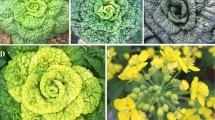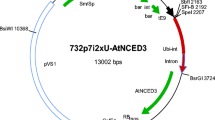Abstract
Anther culture offers a rapid method of generating homozygous lines for breeding program and genetic analysis. To produce homozygous transgenic lines of rice (Oryza sativa L.) in one step, we developed an efficient protocol of anther-callus-based transformation mediated by Agrobacterium after optimizing several factors influencing efficient transformation, including callus induction and Agrobacterium density for co-cultivation. Using this protocol, we obtained 145 independent green transformants from five cultivars of japonica rice by transformation with a binary vector pCXK1301 bearing the rice gene, Xa21 for resistance to bacterial blight, of which 140 were further confirmed by PCR and Southern hybridization analysis, including haploids (32.1%), diploids (62.1%) and mixoploids (7.5%). Fifteen diploids were found to be doubled haploids, which accounted for 10.7% of the total positive lines. Finally, by including 28 from colchicine induced or spontaneous diploidization of haploids later after transformation, a total of 43 doubled haploids (30.7%) of Xa21 transgenic lines were obtained. We also generated two RNAi transgenic haploids of the rice OsMADS2 gene, a putative redundant gene of OsMADS4 based on their sequence similarity, to investigate its possible roles in rice flower development by this method. Flowers from the two OsMADS2 RNAi transgenic haploids displayed obvious homeotic alternations, in which lodicules were transformed into palea/lemma-like tissues, whereas identities of other floral organs were maintained. The phenotypic alternations were proved to result from specific transcriptional suppression of OsMADS2 gene by the introduced RNAi transgene. The results confirmed that OsMADS2 is involved in lodicule development of rice flower and functionally redundant with OsMADS4 gene. Our results demonstrated that rice anther culture could be adapted to gene transformation and RNAi analysis in rice.
Similar content being viewed by others
References
Gao D Y, Liu A M, Zhou Y H, Cheng Y J, Xiang Y H, Sun L H, et al. Molecular mapping of a bacterial blight resistance gene Xa-25 in rice. Acta Genetica Sinica, 2005, 32(2): 183–1838
Mang K. Application of biotechnology in plant agriculture in China. Chin J Biotechnol, 1997, 13(3): 131–141
Raina S K Z, Zapata F J. Enhanced anther culture efficiency of indica rice (Oryza sativa L.) through modification of culture media. Plant Breed, 1997, 116: 305–315
Zeng Q, Wu Q, Feng D J, Zhou K D, Liu X, Zhu Z. Anther culture generated stem borer-resistance DH lines of Minghui 81(Oryza sativa L. subsp. indica) expressing modified crylAc gene. Chin J Biotech, 2002, 18(4): 442–446
Azhakanandam K M, Power J, Lowe K, Cocking E, Davey M. T-DNA transfer, integration, expression and inheritance in rice: effects of plant genotype and Agrobacterium super-virulence. J Plant Physiol, 2000, 157:429–440
Dong J, Teng W, Buchholz WG, Hall TC. Agrobacterium-mediated transformation of Japonica rice. Mol Breed, 1996, 2: 267–276
Hiei Y, Ohta S, Komari T, Kumashiro T. Efficient transformation of rice (Oryza sativa L.) mediated by Agrobacterium and sequence analysis of the boundaries of the T-DNA. Plant J, 1994, 6(2): 271–282
Hiei Y, Komari T, Kubo T. Transformation of rice mediated by Agrobacterium tumefaciens. Plant Mol Biol, 1997, 35(1–2): 205–218
Rhodora R Aldemita, Thomas K Hodges. Agrobacterium tumefaciens-mediated transformation of japonica and indica rice varieties. Planta, 1996, 199(4): 612–617
Lin Y J, Zhang Q. Optimising the tissue culture conditions for high efficiency transformation of indica rice. Plant Cell Rep, 2005, 23(8): 540–547
Park S H, Pinson S R, Smith R H. T-DNA integration into genomic DNA of rice following Agrobacterium inoculation of isolated shoot apices. Plant Mol Biol, 1996, 32(6): 1135–1148
Rashid H, Toriyama Y S, Hinata K. Transgenic plant production mediated by Agrobacterium in Indica rice. Plant Cell Rep, 1996, 15: 727–730
Toki, S, Rapid and efficient Agrobacterium-mediated transformation in rice. Plant Mol Biol Rep, 1997, 15: 16–21
Upadhyaya N, Surin B, Ramm K, Gaudron J, Schünmann P, Taylor W, Waterhouse P, Wang M. Agrobacterium-mediated transformation of Australian rice cultivars Jarrah and Amaroo using modified promoters and selectable markers. Australian J Plant Physiol, 2000, 27: 201–210
Ye S Q, Chu C C, Cao S Y, Tang Z S, Wang L, Zhao S M, et al. The factors of improving rice transformation efficiency. Yi Chuan Xue Bao, 2001, 28(10): 933–938
Yi Z L, Cao S Y, Wang L, Chu C C, Li X, He S J, et al. Improvement of transformation frequency of rice mediated by Agrobacterium. Yi Chuan Xue Bao, 2001, 28(4): 352–358
Zhang J, Xu R J, Elliott M C, Chen D F. Agrobacterium-mediated transformation of elite indica and japonica rice cultivars. Mol Biotechnol, 1997, 8: 223–231
Fukuoka H, Ogawa T, Matsuoka M, Ohkawa Y, Yano H. Direct gene delivery into isolated microspores of rapeseed (Brassica napus L.) and the production of fertile transgenic plants. Plant Cell Reports 1998, 17(5): 323–328
Jahne A, Becker D, Brettschneider R, Lörz H. Regeneration of transgenic, microspore-derived, fertile barley. Theor Appl Genet, 1994, 89: 525–533
Datta S K. Androgenic haploids: Factors controlling development and its application in crop improvement. Current Sci, 2005 89: 1870–1878
Baisakhi N, Dattai K, Olivai N, Ona I, Rao G J N, Mew T W, Datta S K. Rapid development of homozygous transgenic rice using anther culture harboring rice chitinase gene for enhanced sheath blight resistance. Plant Biotech, 2001, 18: 101–108
Si H, Fu Y, Xiao H, Hu G, Cao J, Huang D, Sun Z. Homozygous lines of transgenic rice (Oryza sativa L.) obtained via anther culture. Chin J Rice Sci, 1999, 13: 19–24
Xiao H, Wang Y, Liu D, Wang W, Li X, Zhao X, et al. Functional analysis of the rice AP3 homologue OsMADS16 by RNA interference. Plant Mol Biol, 2003, 52(5): 957–966
Chen J, Tang W H, Hong M M, Wang Z Y. OsBP-73, a rice gene, encodes a novel DNA-binding protein with a SAP-like domain and its genetic interference by double-stranded RNA inhibits rice growth. Plant Mol Biol, 2003, 52(3): 579–590
Kusaba M, Miyahara K, Iida S, Fukuoka H, Takano T, Sassa H, et al. Low glutelin content1: a dominant mutation that suppresses the glutelin multigene family via RNA silencing in rice. Plant Cell, 2003, 15(6): 1455–1467
Prasad K, Vijayraghavan U. Double-stranded RNA interference of a rice PI/GLO paralog, OsMADS2, uncovers its second-whorlspecific function in floral organ patterning. Genetics, 2003, 165(4): 2301–2305
Fornara F, Parenicova L, Falasca G, Pelucchi N, Masiero S, Ciannamea S, et al. Functional characterization of OsMADS18, a member of the AP1/SQUA subfamily of MADS box genes. Plant Physiol, 2004, 135(4): 2207–2219
Moritoh S, Miki D, Akiyama M, Kawahara M, Izawa T, Maki H, et al. RNAi-mediated silencing of OsGEN-L (OsGEN-like), a new member of the RAD2/XPG nuclease family, causes male sterility by defect of microspore development in rice. Plant Cell Physiol, 2005, 46(5): 699–715
Xu Y, McCouch S R, Zhang Q. How can we use genomics to improve cereals with rice as a reference genome? Plant Mol Biol, 2005, 59(1): 7–26
Wang W M, Zhou Y I, Li X B, Zheng X W, Zhang Q, Wang G L, et al. Breeding bacterial blight-resistant hybrid rice with the cloned bacterial blight resistance gene Xa21. Mol Breed, 2002, 8(4): 285–293
Chuang C F, Meyerowitz E M. Specific and heritable genetic interference by double-stranded RNA in Arabidopsis thaliana. Proc Natl Acad Sci U S A, 2000, 97(9): 4985–4990
Li L C, Qu R D, Beachy R N. An improved rice transformation system using the biolistic method. Plant Cell Reports, 1993, 12: 250
Zhai W X, Li X B, Tian W Z, Zhou Y, Pan X B, Cao S Y, et al. Transfer 5 Chinese rice varieties with the cloned bacterial blight resistance gene Xa21 through Agrobacterium-mediated transformation. Sci China Ser C-Life Sci (in Chinese), 2000, 30(2): 200–206
He L, Zhou P, Liu X, Cao X, Cao M, Liu Y. Studies on the Autotetraploid of Triaiihena lutarioriparia L. Liou sp. nov. Chin J Genet, 1998, 25: 49–55
McCouch S R, Kochert G, Yu Z H, Wang Z Y, Khush G S, Coffman W R, et al. Molecular mapping of rice chromosomes. Theor Appl Genet, 1988, 76: 815–829
Wang G L, Song W Y, Ruan D L, Sideris S, Ronald P C. The cloned gene, Xa21, confers resistance to multiple Xanthomonas oryzae pv. oryzae isolates in transgenic plants. Mol Plant Microbe Interact, 1996, 9(9): 850–855
Zhao B, Wang W M, Zheng X W, Wang C L, Ma B J, Xue Q Z, Zhu L H, Zhai W X. Introduction of wide spectrum rice bacterial blight resistance gene Xa21 into two-line genic male sterile rice variety Pei’ai 64S. Chin J Biotech, 2000, 16(2): 137–141
Cheng Z, Buell C R, Wing R A, Gu M, Jiang J. Toward a cytological characterization of the rice genome. Genome Res, 2001, 11(12): 2133–2141
Jiang J, Gill B S, Wang G L, Ronald P C, Ward D C. Metaphase and interphase fluorescence in situ hybridization mapping of the rice genome with bacterial artificial chromosomes. Proc Natl Acad Sci U S A, 1995, 92(10): 4487–4491
Chen Y. Anther and pollen culture of rice. In: Hu H, Yang H Y, eds. Haploids of Higher Plants in vitro. Beijing-Berlin-Heidelberg: China Academic Publishers and Springer-Verlag 1986. 3–25
Sun Z, Zhao C. Anther culture for rice breeding: the CNRRI program. In: Zheng K, Murashige T, eds. Anther culture for rice breeders: Proceedings of Workshop on Anther Culture, Hangzhou, China, 1992. 112–116
Afolabi A S, Worland B, Snape J W, Vain P. A large-scale study of rice plants transformed with different T-DNAs provides new insights into locus composition and T-DNA linkage configurations. Theor Appl Genet, 2004, 109(4): 815–826
Li X B, Yi C D, Zhai W X, Yang Z Y, Zhu L H. A genetically modified japonica restorer line, C418-Xa21, and its hybrid rice with bacterial blight resistance. Chin J Biotech, 2001 Jul, 17(4): 380–384
Kamisugi Y, Nakayama, Nakajima R, Ohtsubo H, Ohtsubo E, Fukui K. Physical mapping of the 5S ribosomal RNA genes on rice chromosome 11. Mol Gen Genet, 1994, 245(2): 133–138
Kang H G, Jeon J S, Lee S, An G. Identification of class B and class C floral organ identity genes from rice plants. Plant Mol Biol, 1998, 38(6): 1021–1029
Al-Forkan M, Power J B, Anthony P, Lowe K C, Davey M R. Agrobacterium-mediated transformation of Bangladeshi Indica rices. Cell Mol Biol Lett, 2004, 9(2): 287–300
Yoshida S, Watanabe K, Fujino M. Non-random gametoclonal variation in rice regeneranis from callus subcultured for a prolonged period under high osmotic stress. Euphytica, 1998, 104: 87–94
Cheng M, Lower B A, Michael S T, Ye X, Armstrong C L. Invited review: Factors influencing Agrobacterium-mediated transformation of monocotyledonous species. In vitro Cellular and Developmental Biology—Plant, 2004, 40(1): 31–45
Lee S, Jeon J S, An K, Moon Y H, Lee S, Chung Y Y, An G. Alteration of floral organ identity in rice through ectopic expression of OsMADS16, Planta, 2003, 217(6): 904–911
Nagasawa N, Miyoshi M, Sano Y, Satoh H, Hirano H, Sakai H, et al. SUPERWOMANI and DROOPING LEAF genes control floral organ identity in rice. Development, 2003, 130(4): 705–718
Terada R, Urawa H, Inagaki Y, Tsugane K, Iida S. Efficient gene targeting by homologous recombination in rice. Nat Biotechnol, 2002, 20(10): 1030–1034
Cotsaftis O, Guiderdoni E. Enhancing gene targeting efficiency in higher plants: rice is on the move. Transgenic Res, 2005, 14(1): 1–14
Schaefer D G. Gene targeting in Physcomitrella patens. Curr Opin Plant Biol, 2001. 4(2): 143–150
Author information
Authors and Affiliations
Corresponding author
Additional information
The authors contributed equally to this work.
Rights and permissions
About this article
Cite this article
Chen, C., Xiao, H., Zhang, W. et al. Adapting rice anther culture to gene transformation and RNA interference. SCI CHINA SER C 49, 414–428 (2006). https://doi.org/10.1007/s11427-006-2013-2
Received:
Accepted:
Issue Date:
DOI: https://doi.org/10.1007/s11427-006-2013-2




